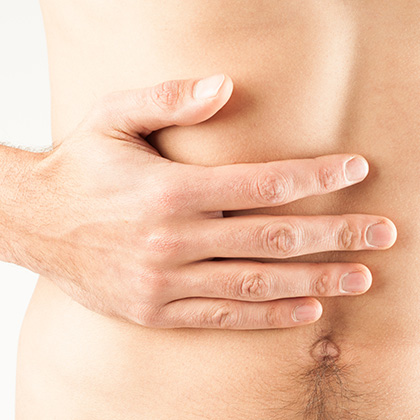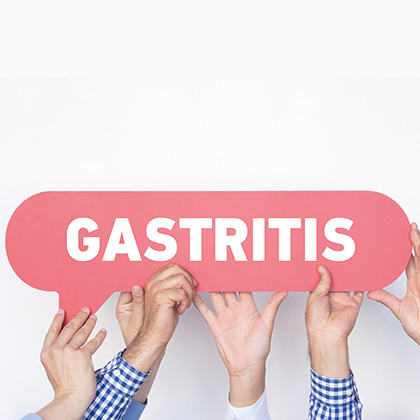People may often joke about flatulence and wind. But passing wind is something we all do. According to the charity Guts UK, the average person passes wind through the rectum (commonly known as farting) 15 times a day. Even someone who breaks wind 40 times a day is considered normal (i).
Here are some facts about flatulence and wind that you should know:
What’s the difference?
Flatulence and wind are symptoms related to gas in the gastrointestinal system. Flatulence is a term that’s usually used to describe passing gas (or flatus) through the rectum, while wind can mean either flatulence or belching (passing wind from the stomach through the mouth, often called burping). Wind may also be used to describe the feeling of being bloated, where gas trapped in the stomach or abdomen causes pain or discomfort (also known as trapped wind).
Trapped wind can cause belching, flatulence and other symptoms such as rumbling or gurgling noises in your stomach or abdomen (borborygmi).
What makes you swallow more air?
Eating too quickly and gulping down your food is thought to make you swallow more air, as can drinking too quickly or drinking too much when you’re eating, chewing gum, smoking and wearing loose dentures. Drinking fizzy drinks, meanwhile, releases carbon dioxide into the stomach.
What makes wind smell?
The main gases in wind are odourless. But wind also contains small amounts of other compounds called indoles and skatoles, as well as sulphur-containing gases such as hydrogen sulphide, and it’s these substances that cause the smell. If you want to avoid producing smelly gas, you may want to avoid eating foods that produce indoles, skatoles and hydrogen sulphide in the gut, such as garlic, spices, onions and certain herbs belonging to the fennel family. Eating lots of fatty food can also produce smelly wind, plus some people produce more hydrogen sulphide when they drink beer, white wine and fruit juices.
Wind: how your diet can help
If you’re affected by excessive wind or trapped wind, it’s no joke. Not only can trapped wind make you feel uncomfortable physically, it can also make you feel embarrassed when you’re around other people – which in turn can affect your self-confidence. The good news is you may be able to tackle the problem by making changes to how you eat and what you eat.
How you eat
If you tend to eat in a hurry or – worse – on the go, it could make you produce more wind than normal. Although it may not always be possible, try to eat in a relaxed environment, as staying calm may help soothe your digestion. Chew your food slowly and deliberately, but make sure your mouth is closed when you eat as it can help prevent you swallowing too much air. Try not to gulp down drinks too, and avoid drinking through a straw (try to avoid eating and drinking at the same time too). It’s also a good idea to avoid wearing clothes with tight waist bands when you eat, as they put extra pressure on your abdomen.
Meanwhile, you could also try eating smaller, more frequent meals than your usual two or three main meals a day. Consider eating up to six mini meals at regular intervals to keep your bowel working (according to the charity Crohn’s & Colitis UK, an empty bowel produces more wind (ii)).
Also try not to have your last meal of the day too close to bedtime if you find eating late at night gives you wind (eat your last meal at least three hours before going to bed).
What you eat
Some foods are well known for producing more gas than others when you eat them, including baked beans, onions, cauliflower, cabbage, leeks, garlic, lentils, pulses, turnips, sprouts and broccoli. Some of these may affect you, while others may not. All you have to do is try to identify which foods make you produce a lot of gas, and then limit them in your diet (do, however, make sure you still get your five portions of fruit and veg every day).
On the other hand, if eating dairy foods gives you wind, you may not be able to digest lactose, the sugar in cow’s milk. This condition is called lactose intolerance, and besides wind you may have other symptoms such as abdominal cramps. If you suspect you may have lactose intolerance, your GP can carry out tests that will confirm it and offer dietary advice. Other medical conditions that may cause wind and flatulence include coeliac disease and Crohn’s disease.
Besides the obvious gas-forming foods, there are other things you may want to avoid, including the following:
-
Fatty foods and eggs, which can produce smelly gas
-
Foods that contain an artificial sweetener called sorbitol (such as jams, sweets and sugarless gum)
-
Spicy food
-
Raw vegetables
-
Foods containing a lot of bran fibre
-
Some cooked carbohydrate foods that have been left to cool, such as pasta and potatoes (these produce resistant starch, which can cause bloating and wind)
It’s also a good idea to keep a food diary, where you make a note of everything you eat and how you feel, including any symptoms you notice. This can help you to pinpoint which food or foods you might want to try cutting back on or avoiding.
Finally, try finishing off your meal with a cup of peppermint tea, as some people find peppermint helps to relieve abdominal bloating.
Health conditions associated with trapped wind
Trapped wind can also be a symptom of irritable bowel syndrome, find more information about the symptoms of IBS, as well as some foods to avoid.
Sometimes people with coeliac disease can also experience flatulence as a result of their condition. If you think you could have a chronic problem with trapped wind, see our guide on the causes and symptoms of coeliac disease.
Treatments for flatulence and wind
As well as watching what you eat and drink, you can take over-the-counter remedies for flatulence and wind. These include the following:
Charcoal tablets
Charcoal is thought to be able to absorb the gas in your gut and make you feel more comfortable. However, if you’re taking any other medicines, charcoal tablets may not be recommended, as it can reduce the effectiveness of other medicines. If in doubt, always ask your GP or pharmacist for advice.
Simeticone
Over-the-counter preparations that contain this ingredient may help relieve the symptoms of trapped wind. Simeticone is known as an anti-foaming agent as it works by breaking down the tiny bubbles of gas that get trapped in your gut, and is even suitable to take during pregnancy (always speak to your doctor or pharmacist before using any medicines during pregnancy).
Antacids
While used primarily for indigestion and heartburn, antacid tablets are also recommended for trapped wind as they help to neutralise excess stomach acid.
Alpha-galactosidase
This is an enzyme made naturally in the body that’s thought to help you to digest carbohydrates. Some people find that, when taken as a dietary supplement, alpha-galactosidase can help relieve wind. One study, for instance, suggests it may help to reduce flatulence after eating beans (iii).Meanwhile, your GP may prescribe antibiotics if you have excess wind caused by a small intestinal bacterial overgrowth.
Wind-relieving exercises
If you’re inactive, gas may build up in your system, causing pain and discomfort. But regular exercise can help improve the movement of food and gas through your gut. A gentle walk after mealtimes is all you may need to help move gas through your system more effectively. Meanwhile, there are a few easy yoga poses you could try that many people believe help relieve wind. These poses, which help to compress your digestive tract, which may help with the movement of gas through your digestive system, include the following:
Child’s pose (balasana)
Start by kneeling on all fours on an exercise mat or towel. Your knees should be about hip width apart. Lower your hips back towards your heels and fold your torso over your thighs, while stretching your arms forward and keeping your palms down on the mat. If you’re flexible enough, place your forehead on the mat, between your upper arms. Feel your spine, shoulders and neck relax. Avoid this pose if you’re pregnant or if you have high blood pressure, or an eye or ear infection. Also take care if you have a knee or ankle problem.
Wind-relieving pose (pavanamuktasana)
Lie on your back on an exercise mat or towel with your legs and arms extended. Take a couple of deep breaths and try to relax as much as possible. Lift both legs, drawing your knees into your chest. Clasp your hands around your knees, and try to get your knees as close to your chin as possible (your thighs should be resting on your stomach). To deepen the stretch, raise your head slowly and touch your forehead on your knees. Hold this pose for a minute or two before releasing and extending both legs.
Alternatively, clasp your hands around one knee, keeping your head on the floor. Release the other knee so that your leg extends in front of you on the floor. Hold for a few deep breaths, then draw the extended leg back up and clasp both knees again. If you find this difficult, try bending the knee of the extended leg and put the foot flat on the floor. Then release the opposite knee and extend the leg along the floor, holding the pose for another few deep breaths. Clasp both knees to your chest, then release. You can also perform the alternating leg variation with your forehead on each drawn-in knee. Avoid this pose if you’re pregnant or if you have a spinal injury or sciatica. You should also not practise it if you’re recovering from abdominal surgery or a hernia.
Natural remedies for wind and flatulence
Making changes to your diet and lifestyle may well help relieve trapped wind and flatulence. There are also several natural remedies you could try too, including the following:
Soluble fibre
If a sluggish gut is the cause of your trapped wind, you may need to improve your intestinal environment by eating more soluble fibre. Fructo-oligosaccharides (FOS) are starches that your body cannot digest fully – the undigested parts provide food for the bacteria in your digestive system. You can find FOS in foods such as asparagus, Jerusalem artichoke, leeks, onions and soya beans. It’s also available as a nutritional supplement. However, some people may find eating too many foods that contain FOS can cause flatulence.
Turmeric
Often used as a home remedy for flatulence, turmeric – the yellow spice that colours and adds flavour to many Indian dishes – has been shown to improve the symptoms of dyspepsia, which include wind, bloating and belching (iv). It may also help soothe the discomfort of trapped wind, as many natural health practitioners also believe the active ingredient in turmeric, called curcumin, provides natural pain relief.
Peppermint oil
Peppermint is traditionally known as a carminative herb, which means it’s a herb that either prevents the forming of gas in the digestive tract or it helps to move gas through the intestines and out of the body. Indeed, studies have shown that enteric-coated peppermint oil capsules may help reduce IBS symptoms, one of which is wind (v). Other carminative herbs include anise, caraway, cardamom, chamomile, coriander, cumin, fennel, garlic, parsley and spearmint.
Ginger
Also a carminative herb, ginger may be useful as it has a soothing effect on the digestion, helping to relieve stomach discomfort and pain. Try adding fresh ginger to your food, treating yourself to a piece or two of crystallised ginger, drinking ginger tea or taking a high-strength ginger supplement.
Vitamin B12
Many natural health practitioners recommend vitamin B12 for digestion problems such as flatulence and trapped wind, as it’s thought a lack of B12 may make your digestive system sluggish. You can find B12 in fish, seafood, cheese, liver, red meat, eggs and some fortified foods such as breakfast cereals. If your blood levels of B12 are low, you can also take it as a supplement.
PEA
Also known as palmitoylethanolamide, PEA is a type of fatty acid made naturally by the body and found in all cells, tissues and fluids including the brain (it’s also found in foods such as soya beans, peanuts, eggs, flaxseed and milk). Described as an endocannbinoid-like chemical that belongs to a family of fatty acid compounds called amides (vi), PEA is an alternative to CBD, since both substances are thought to have similar properties including the ability to reduce pain and inflammation. However researchers suggest PEA is safer than CBD, since it has been studied more extensively and has a more robust safety profile (vii) with no known side effects (vi).
Your body naturally increases its production of PEA when your cells are damaged or threatened. But in certain situations – such as when your body is experiencing chronic inflammation – the level of PEA in your cells drops (vi). When this happens, PEA supplements may be helpful. In fact a review of 16 clinical trials and meta-analysis of PEA suggests it does have analgesic actions – in other words it helps to relieve pain (viii).
While managing flatulence and trapped wind can be uncomfortable, these simple steps should help. To find more information about common health conditions, read the articles in our health library.
References:
-
Available online: https://gutscharity.org.uk/advice-and-information/symptoms/bloating-and-wind/
-
Available online: https://www.crohnsandcolitis.org.uk/about-crohns-and-colitis/publications/bloating-wind
-
Di Stefano. M, Miceli. E, Gotti. S ,et al. The effect of oral alpha-galactosidase on intestinal gas production and gas-related symptoms. Dig Dis Sci. 2007 Jan;52(1):78-83. Epub 2006 Dec 7.
-
Thamlikitkul. V, Bunyapraphatsara. N, Dechatiwongse. T, et al. Randomized double blind study of Curcuma domestica Val. for dyspepsia. J Med Assoc Thai. 1989;72:613-620
-
Capello G et al., Peppermint oil (Mintoil) in the treatment of irritable bowel syndrome: a prospective double blind placebo-controlled randomized trial. Dig Liver Dis. 2007 Jun;39(6):530-6.Available online: https://www.ncbi.nlm.nih.gov/pubmed/17420159
-
Clayton P. et al., Palmitoylethanolamide: A Natural Compound for Health Management. Int J Mol Sci. 2021 May;22(10): 5305. Available online: https://www.ncbi.nlm.nih.gov/pmc/articles/PMC8157570/
-
Clayton P. et al., Palmitoylethanolamide: A Potential Alternative to Cannabidiol. J Diet Suppl. 2021 Nov;28;1-26. Available online: https://www.tandfonline.com/doi/full/10.1080/19390211.2021.2005733
-
Gabrielsson . L, Mattsson. S, Fowler. CJ. Palmitoylethanolamide for the treatment of pain: pharmacokinetics, safety and efficacy. Br J Clin Pharmacol. 2003;110:359-362.Available online: https://www.ncbi.nlm.nih.gov/pmc/articles/PMC5094513/
Related Posts
Disclaimer: The information presented by Nature's Best is for informational purposes only. It is based on scientific studies (human, animal, or in vitro), clinical experience, or traditional usage as cited in each article. The results reported may not necessarily occur in all individuals. Self-treatment is not recommended for life-threatening conditions that require medical treatment under a doctor's care. For many of the conditions discussed, treatment with prescription or over the counter medication is also available. Consult your doctor, practitioner, and/or pharmacist for any health problem and before using any supplements or before making any changes in prescribed medications.

Christine
Christine Morgan has been a freelance health and wellbeing journalist for almost 20 years, having written for numerous publications including the Daily Mirror, S Magazine, Top Sante, Healthy, Woman & Home, Zest, Allergy, Healthy Times and Pregnancy & Birth; she has also edited several titles such as Women’ Health, Shine’s Real Health & Beauty and All About Health.
View More



